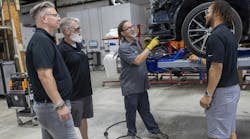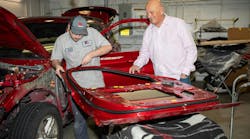Tammie Harper prides herself in taking exhaustive measures in the name of customer service.
One day, early in her professional career, Harper took a chance and answered a newspaper advertisement for a receptionist job, only to pull up to a body shop that looked rough around the edges.
Her first thought was, “I’m going to turn and run.”
But she didn’t.
She had a one-year-old child to care for and decided she needed to give the job a chance. Fast forward six years, and she had moved from receptionist to office manager at the same body shop.
Harper moved onto a second collision repair shop and spent another seven years there. At this body shop, she learned estimating.
She found her final “home” at Autocraft Bodywerks in Austin, Texas and has been there for about seven years.
As general manager of the body shop, she runs the operation’s newest location, a 100 percent Tesla-dedicated body shop in Austin and one that is projected to have around $2 million in annual revenue in 2020, its first year. She tries to do everything in her power to take care of the customers and treat them more like “guests.”
“In order to really make the shop run, you’ve got to be careful on writing the estimate and capturing everything you need,” Harper says. “You can’t just go down the street to a dealership and get parts.”
Harper runs a team of seven and each day she aims to go the extra mile for the customer.
As told to Melissa Steinken
My typical day is going to start at 7:45 a.m. and ends around 6 p.m. I get into the shop about 15 minutes before the shop opens at 8 a.m. for the day. We have a small shop. The first thing we do when we get here is clean. We sweep and mop floors. Since COVID-19, we’ve been adding an extra step to sanitize the entire shop. Then, I will talk over the production for the day with my painters, technician and parts person so we’re on the same page as to when cars are being delivered. If a car is scheduled for delivery, for example, at 2 p.m., I expect the car to be ready by 1 p.m.
Once the production meeting ends, I start running the shop from start to finish. I tackle everything from writing estimates, filing paperwork to closing the books. I pretty much help out with everything in the shop if I can. I do have a parts person that oversees ordering online parts.
As a Tesla shop, we like to prioritize parts ordering and organizing. I like to take time out of the day to check on tickets and take a look at the parts. I make sure all the parts are in. I like to order too much rather than not enough. If they’re missing, then I need to figure out where we will have to get them because there are no local dealerships here in which you can just go to at the last minute.
Depending on how many cars are in the lot, this ticket checking process might take me about two hours or so to do every day. Typically, we don’t bring the car into the body shop until the parts get here and can be mirror-matched.
Here are the trickiest elements of working on Teslas: You need to be sure you’re up to date on the latest bulletins or superceded parts on the model you’re working on. If you’re not, you could very easily order wrong parts, or not enough parts, for the changes.
Tesla has come a long way on parts ordering. I remember the days where we had to write out the parts number, the description, look up costs in their catalogs, and send over an order by email. When you had a large parts order it was a nightmare. Now it’s just like ordering on Amazon. Ordering the correct parts the first time is key. If you don’t, it can kill your cycle time.
The body shop has two locations and each location does repair Teslas. Our south location repairs all makes and models of vehicles, including Teslas and then here, at our north location, we exclusively cater to Tesla vehicles. Our average monthly car count is about 50 cars per month. It’s slowed down a little recently due to the coronavirus pandemic and right now we see about 20 cars each month.
I’ve never been at a body shop that only repairs one brand. I’ve always worked at body shops where the repairs were done on a mixture of vehicles. It’s been an experience. Since we’ve opened this shop, it’s been a neat experience to learn the different models of Tesla. We like to call ourselves the masters of Tesla.
I think every vehicle manufacturer will eventually design an EV because it’s the wave of the future. Every Tesla owner that I’ve spoken to will never go back to gas vehicles.
To stay on track with tasks, I use CCC ONE. We’ve switched from using PofitNet to using CCC, which has been a tremendous help. It’s organized in itself and it runs a repair plan so that you can use a sliding scale to know where cars are in the production management program.
Shop: Autocraft Bodywerks Owner: Chris Raeder Location: two locations in Austin, Texas Staff Size: 6 at main, North location (1 parts department, 2 body technicians, 1 detailer/quality control, 2 painters Shop Size: 7,000 square feet Average Monthly Car Count: 120 combined Annual Revenue: approximately $7 million combined



